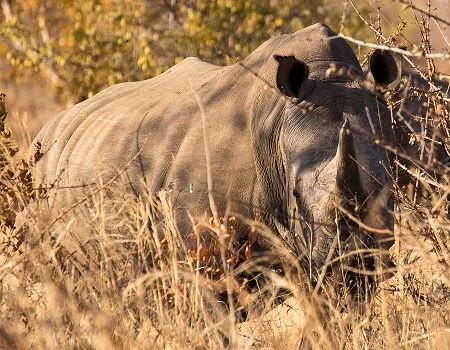On Safari: See Rhinos in Zambia
Rhinos are a wildlife preservation success story in Africa. See the mighty animals first-hand in Zambia.

A rhino in Mosi-oa-Tunya National Park. Photo by William S. Liebman.
Rhinos are back in Zambia. Thousands of these animals roamed Zambia’s plains 40 years ago, but by 2010 only one white rhino remained. We watch five of the massive 6,000-pounders in Mosi-oa-Tunya National Park, a park that has nine rhinos.
Travelers visit the park primarily to see Victoria Falls, the world’s largest waterfall based on the sheer volume of cascading water. Locals long ago named the place where the Zambezi River tumbles 355-feet “Mosi-oa-Tunya,” or the “smoke that thunders.” The sheer power of the falls amazes, but the quietly grazing herd of nine represents a conservation success that is also spectacular.
Working together, the African Wildlife Foundation and the Zambia Wildlife Authority relocated four white rhinos from South Africa to Mosi-oa-Tunya, bringing the park’s count to five. The animals survived the complicated journey, acclimated well to their new surroundings and the females gave birth to four calves. This is especially significant since rhinos birth a calf only once every two to four years.

A Zambian sunset. Photo by William S. Liebman.
It’s best to plan ahead to see the rhinos since the visit must be coordinated with the Zambia Wildlife Authority. First, our Wilderness Safaris’ guide Histon drives to a post to pick up our armed escort who remains in contact with the rifle-toting guards who protect the rhinos around-the—clock from poachers. The guard directs Histon to a location, which changes since the rhinos roam. After we get out of our vehicle, another guard joins us, reminding us to walk in single file, be quiet and no matter what happens, do not run.
After a few minutes of walking through the tall grass, the guard whispers “Over there.” Initially we see some gray behind the tall grass. Even at six-feet high at the shoulder, the animals blend somewhat with the environment. Then they move forward. The prehistoric-looking animals with their thick skin, horns, rounded bellies and faces only a mother could love, keep busily grazing. They are square-lipped rhinos, or white rhinos, a designation which does not refer to the animals’ gray color. In Afrikaans “wyd” means “wide.” Early English settlers misheard the term and labeled the rhinos “white.”
Indifferent to us, the rhinos seem docile until “Lester,” the big male, stops eating and moves close to the female. He sniffs her rear and she responds with snorts and a quick thud-like turn and step toward us, scary enough to make one person in our group run until we stopped him. The guards tell us it’s time to leave, not because the rhino noticed the runner, but because Lester is lascivious and there’s likely to be a good deal of rhino rhumba.

An elephant at Toka Leya Camp. Photo by William S. Liebman.
Some companies offer rhino walking safaris, 3-hour treks through Mosi-oa-Tunya on foot. We visit the rhinos on an outing from Toka Leya Camp. Located in the park on the banks of the Zambezi, Toka Leya offers 12 safari-style tents, each with a private bathroom and a deck. We always hear the rushing river. On several walks from our tent to the main lounge we encounter elephants chewing the tree branches next to the elevated walkway. One morning we awake to monkeys scampering across our deck. Staying at Toka Leya, an upmarket camp, provides a great way to explore Mosi-oa-Tunya.
To book Wilderness Safaris, contact Travel Sommelier.
Have you been on safari? What were the most memorable parts? Share your comments with me on Twitter, @familyitrips.